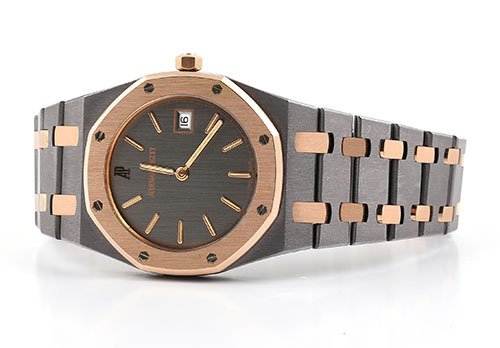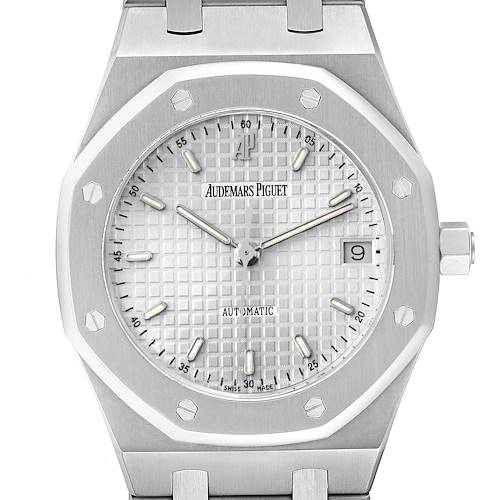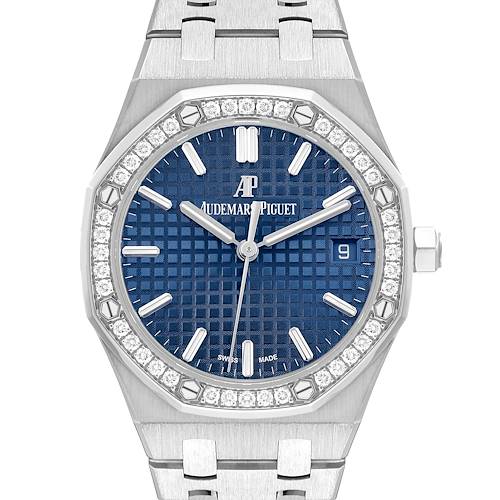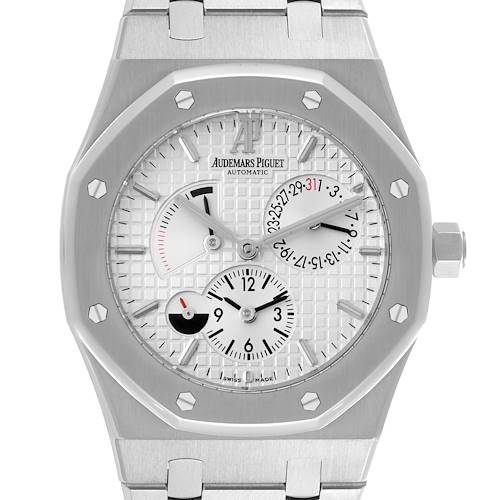- CALL US (404) 814-1814
- LIVE SUPPORT
- EMAIL US
-
WISHLIST (0)
-
CART(0)

Audemars Piguet Royal Oak Watches
294 MATCHES FOUND
Crafted for enthusiasts of innovation and the art of fine watchmaking, these timepieces are characterized by their distinctive octagonal bezel, integrated bracelet, and Tapisserie dials, attracting attention with their unique style. Embodying the timeless sophistication synonymous with Audemars Piguet, Royal Oak watches effortlessly elevate any ensemble with a refined touch.
IN STOCK

Audemars Piguet Royal Oak Dual Time Rose Gold Mens Watch 26120OR
$33,555

Audemars Piguet Royal Oak Jumbo Yellow Gold Grey Dial Mens Watch 5402BA
SwissWatchExpo ARCHIVE - RECENTLY SOLD

Audemars Piguet Royal Oak Midsize Black Dial Steel Mens Watch 56303ST

Audemars Piguet Royal Oak Blue Dial Steel Mens Watch 15500ST Box Card

Audemars Piguet Royal Oak 37mm Yellow Gold Mens Watch 15451BA Box Card

Audemars Piguet Royal Oak White Dial Steel Mens Watch 15500ST Box Card

Audemars Piguet Royal Oak Black Dial Steel Mens Watch 15500ST Box Card

Audemars Piguet Royal Oak Dual Time Yellow Gold Mens Watch 25730BA

Audemars Piguet Royal Oak 18K Rose Gold Mens Watch 26022OR.OO.D088CR.01

Audemars Piguet Royal Oak White Dial Steel Mens Watch 14790ST Box Papers

Audemars Piguet Royal Oak Black Dial Steel Mens Watch 15300ST + 2 links

Audemars Piguet Royal Oak Moon Grey Dial Steel Yellow Gold Mens Watch 25594SA

Audemars Piguet Royal Oak Rose Gold Chronograph Mens Watch 26331OR Box Card

Audemars Piguet Royal Oak 18k Rose Gold Silver Dial Watch 15300OR

Audemars Piguet Royal Oak Blue Dial Steel Mens Watch 15000ST Box Papers

Audemars Piguet Royal Oak Blue Dial Rose Gold Chronograph Watch 26331OR Box Card

Audemars Piguet Royal Oak 37mm Steel Diamond Mens Watch 15451ST Box Card

Audemars Piguet Royal Oak Dual Time Rose Gold Mens Watch 26120OR

Audemars Piguet Royal Oak Platinum Titanium QE II Cup Watch 15403IP Box Papers

Audemars Piguet Royal Oak Nick Faldo Limited Edition Steel Pt Mens Watch 15190SP Box Papers

Audemars Piguet Royal Oak White Dial Steel Mens Watch 15300ST

Audemars Piguet Royal Oak Chronograph Black Dial Steel Mens Watch 26331ST

Audemars Piguet Royal Oak Black Dial Steel Mens Watch 15300ST

Audemars Piguet Royal Oak Steel Yellow Gold Watch 15000SA Box Papers

Audemars Piguet Royal Oak Black Dial Steel Mens Watch 15400ST Box Card

Audemars Piguet Royal Oak 38mm Chronograph Mens Watch 26315ST Box Card

Audemars Piguet Royal Oak Tantalum Rose Gold Mens Watch 56175TR Box Papers

Audemars Piguet Royal Oak Yellow Gold Mens Watch 15050BA Box Papers

Audemars Piguet Royal Oak Silver Dial Steel Mens Watch 15400ST Box Card

Audemars Piguet Royal Oak Silver Dial Steel Mens Watch 15202ST

Audemars Piguet Royal Oak Chronograph Steel Mens Watch 26315ST Box Card

Audemars Piguet Royal Oak Steel Yellow Gold Mens Watch 14790SA

Audemars Piguet Royal Oak Rose Gold Black Dial Mens Watch 26320OR Box Papers

Audemars Piguet Royal Oak Blue Dial Steel Mens Watch 15000ST Box Papers

Audemars Piguet Royal Oak Black Dial Steel Mens Watch 15400ST Papers
In 1972, the Audemars Piguet Royal Oak collection redefined watch design with its distinct features. Introduced as Audemars Piguet’s response to the Quartz Revolution, the Royal Oak broke the mold by using stainless steel instead of traditional precious metals, and introducing a unique octagonal case, pioneering a new category of watches - the steel luxury sports watch. Today, the Royal Oak continues to be highly coveted for its bold design and technical excellence.
Fusing traditional Swiss craftsmanship with modern aesthetics, Royal Oak watches are available in various materials such as stainless steel, gold, titanium, platinum, and ceramic, catering to diverse preferences for both durable everyday wear and refined elegance. Notable models in the collection include the robust and sporty Royal Oak Offshore, the precise timekeeping and functional Royal Oak Chronograph, and the highly intricate Royal Oak Tourbillon.
The collection has evolved with the introduction of new metals, finishes, precious stones, complications, and technological advancements.
Fifty years since it rocked the watch industry, the appeal of the Audemars Piguet Royal Oak is stronger than ever. To this day, the company continues to improve on their iconic creation with regular upgrades and compelling new variations, all while keeping the classic design of the Royal Oak alive.
How to Sell My Audemars Piquet Royal Oak
Sell or trade-in your Audemars Piquet Royal Oak for the best price with SwissWatchExpo. SwissWatchExpo makes it easy to sell or trade in your used or pre-owned Audemars Piquet Royal Oak to keep your luxury watch collection fresh!
Frequently Asked Questions
What Is A Royal Oak Watch?
The Audemars Piguet Royal Oak is the most famous creation of the Swiss manufacturer. It was the world's first steel luxury sports watch when it debuted in 1972. In addition to the material, the design caused quite an uproar. Created by renowned watch designer Gérald Genta, the original Royal Oak came with an integrated bracelet and porthole-inspired octagonal bezel with eight decorative screws.
Modern models retain these classic characteristics, even as the line expanded to include precious metal and complicated designs.
Do AP Royal Oak Watches Hold Their Value?
Audemars Piguet belongs to the “Holy Trinity” of watch manufactures, alongside Patek Philippe and Vacheron Constantin. These 3 companies have been at the forefront of watchmaking and set the standard for design and craftsmanship.
Aside from their inherent prestige, Audemars Piguet produces about 50,000 watches per year (as of 2022), which is a small number compared to other watch brands that produce more than a million units annually.
What Is The Difference Between Royal Oak And Royal Oak Offshore?
The Audemars Piguet Royal Oak was introduced in 1972, after which it became the first steel luxury sports watch.
By 1993, the company decided on creating a more masculine and sportier version of the classic Royal Oak to attract younger audiences and sport enthusiasts – the result was the Royal Oak Offshore.
Both the Royal Oak and Royal Oak Offshore possess a porthole-shaped case and geometric design. The Royal Oak has thinner profile, with the cases for men’s watches ranging from 39 – 44mm, while the Royal Oak Offshore range from 42 – 45mm.
Their chronograph versions also differ – the Royal Oak Chronograph sports a 3-6-9 layout, while the Royal Oak Offshore Chronograph offers both standard and vertical versions.


























